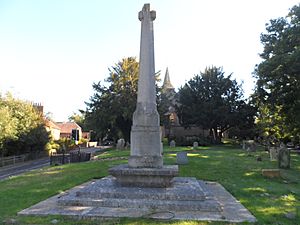Busbridge War Memorial facts for kids
Quick facts for kids Busbridge War Memorial |
|
|---|---|
| United Kingdom | |
 |
|
| For men from Busbridge killed in the First World War | |
| Unveiled | 1922 |
| Location | 51°10′39″N 0°36′08″W / 51.17751°N 0.60210°W St John's Church, Brighton Road, Busbridge, Surrey
|
| Designed by | Sir Edwin Lutyens |
|
Listed Building – Grade II
|
|
| Official name | Busbridge War Memorial |
| Designated | 1 February 1991 |
| Reference no. | 1044531 |
The Busbridge War Memorial is a special monument found in the churchyard of St John's Church in the village of Busbridge, Surrey, England. It was built to remember the brave people from the area who lost their lives in the First World War. A famous architect named Sir Edwin Lutyens designed it. This memorial is considered very important, so it's protected as a Grade II* listed building.
Contents
Remembering the Fallen
After the First World War ended, many towns and villages in Britain wanted to remember the huge number of people who had died. Thousands of war memorials were built across the country. These monuments helped communities honor their fallen heroes.
Sir Edwin Lutyens's Role
One of the most important designers of these memorials was an architect named Sir Edwin Lutyens. He is known as one of the best English architects of his time. Lutyens designed some very famous memorials.
Lutyens's Famous Works
He created The Cenotaph in London, which is now the main place for national Remembrance Day events. He also designed the Thiepval Memorial to the Missing, the largest British war memorial in the world. Lutyens also created the Stone of Remembrance, which you can find in many large cemeteries run by the Commonwealth War Graves Commission. The Busbridge memorial is one of fifteen "War Crosses" designed by Lutyens. They all share a similar look.
Lutyens's Connection to Busbridge
Sir Edwin Lutyens had a special link to Busbridge through his friend, Gertrude Jekyll. She was a famous garden designer. Lutyens designed her house, Munstead Wood, in 1896. They worked together on many garden and country house projects, especially in the Busbridge area.
He also designed several other memorials for the Jekyll family. These are in the same churchyard as the war memorial. Lutyens became famous for designing large country houses for wealthy people. It seems his work on war memorials, like the one in Busbridge, often came from his earlier connections with clients.
Design and History of the Memorial
The Busbridge War Memorial was officially revealed on 23 July 1922. General Sir Charles Monro, 1st Baronet led the ceremony.
The War Cross Design
The memorial is a "War Cross" design by Lutyens. It is made from Portland stone and stands about 7 meters (23 feet) tall. The cross has a unique, diamond-shaped shaft that gets narrower towards the top. It has short arms near the top, connected by special curved shapes.
The cross stands on a base made of four stone blocks. This base then sits on a square stone platform. At the bottom, there are three shallow stone steps. The memorial is placed at the end of the churchyard, where Brighton Road and Hambledon Road meet. This makes it a very noticeable landmark.
Inscriptions and Names
The largest stone at the base of the cross has an important message carved into it. It reads: "MCMXIV–MCMXIX / THEY COUNTED NOT / THEIR LIVES DEAR / UNTO THEMSELVES." These Roman numerals stand for the years of the First World War (1914–1919). Later, the dates for the Second World War (MCMXXXIX–MCMXXXXV, or 1939–1945) were added below the first message.
The names of the people remembered are not on the memorial itself. Instead, their names are written on a special plaque inside the church.
Protected Status
The Busbridge War Memorial was first recognized as a Grade II listed building on 1 February 1991. This means it's an important historical building that needs to be protected.
There are three other memorials designed by Lutyens in the same churchyard. These include memorials to Julia Jekyll (Gertrude's mother), Francis McLaren MP, and a joint memorial to Gertrude, her brother Sir Herbert Jekyll, and his wife Dame Agnes Jekyll. All of these are also Grade II listed. The war memorial is especially important because it is part of this group of memorials and is near St John's Church, which is a Grade II* listed building itself.
In November 2015, during the 100th anniversary of the First World War, Lutyens's war memorials were recognized as a "national collection." Many of his memorials in England had their protection status reviewed. As part of this, the Busbridge memorial was upgraded from Grade II to Grade II*. This shows how important it is considered.
Images for kids



